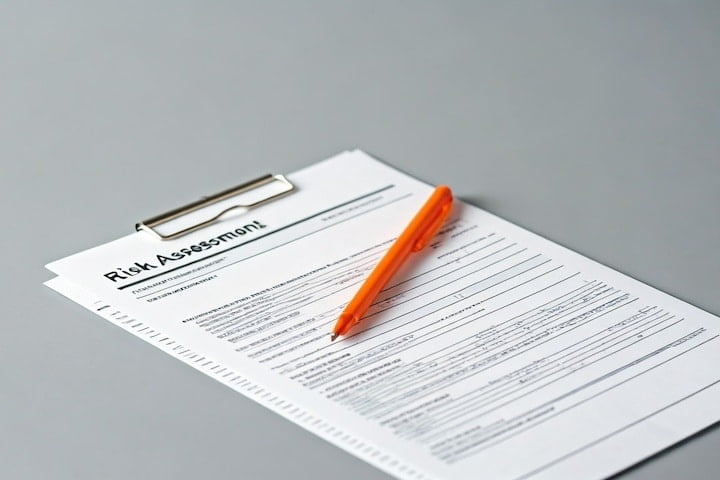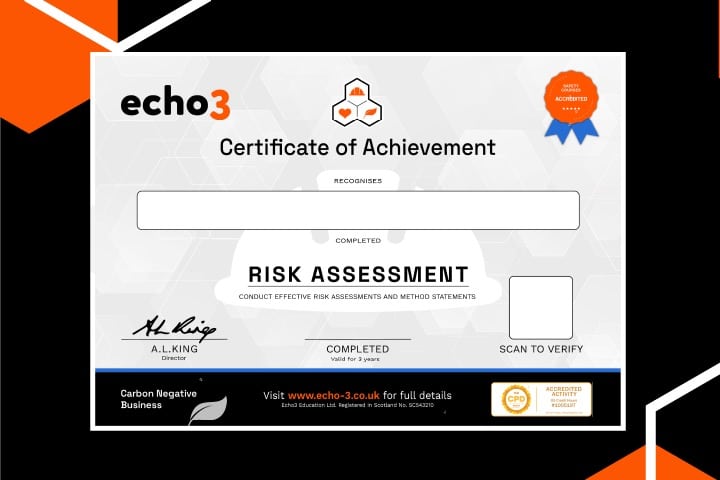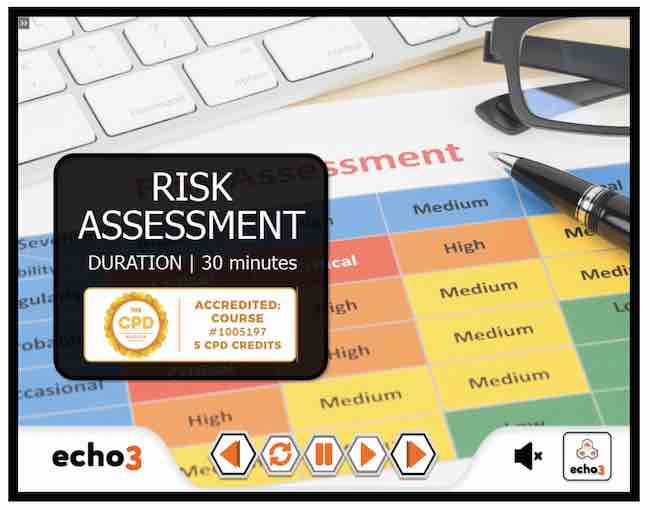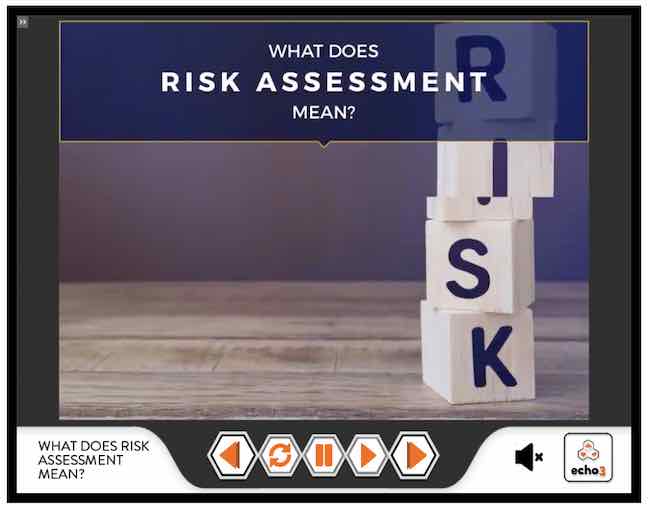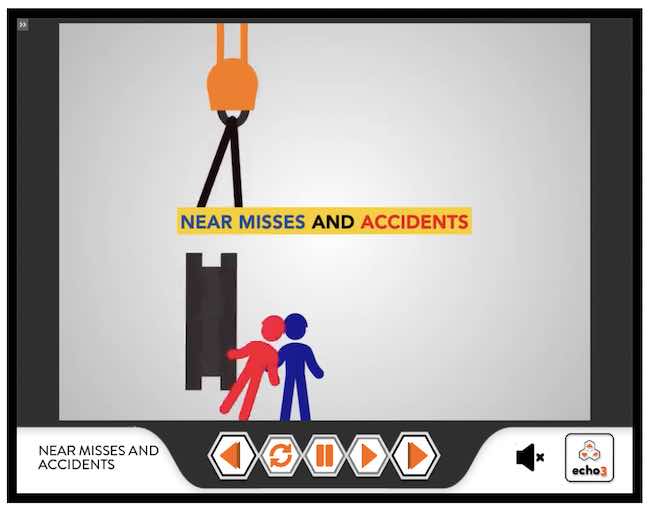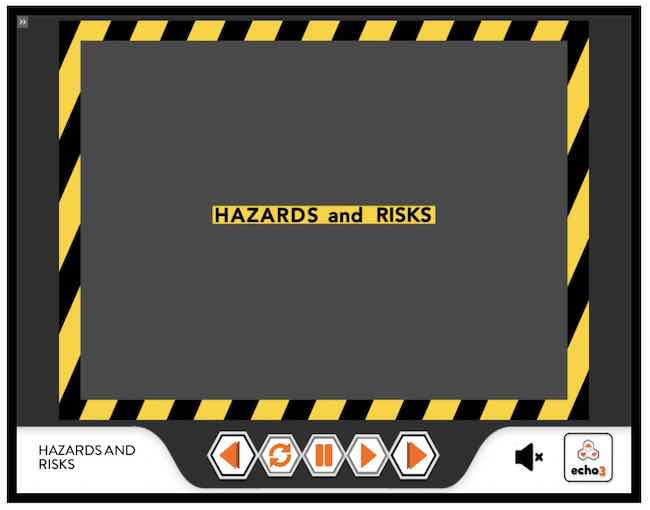Risk Assessment Course
This Risk Assessment course online provides the knowledge needed to undertake appropriate risk assessments.
Employers cannot create a safe workplace without first considering what hazards are present, and how to reduce the chance these hazards causing an injury.
Therefore, UK health and safety regulations require all employers to undertake ‘suitable and sufficient’ risk assessments.
This online Risk Assessment course includes a verifiable, CPD-accredited certificate.
Course Content
UNIT 1 | DEFINITIONS AND LEGISLATION
In this first unit we define the key terminology of risk assessments and explain the underpinning legal requirements. The Unit headings are:
- What does Risk Assessment mean?
- Hazards and Risks
- Example of Hazards and Risks
- Near Misses and Accidents
- Causes of accidents
- Risk Assessment Law
- Hazard-specific Legislation
- Managing Health and Safety
UNIT 2 | THE RISK ASSESSMENT PROCESS
In this second unit we explain how to conduct a risk assessment, setting this out in five easy steps. To support you in completing a risk assessment effectively, we look at some common hazards. We also outline the importance of ongoing monitoring of your risk assessments. The Unit Headings are:
- The Purpose of Risk Assessment
- Conducting Risk Assessments
- Five Steps To Easy Risk Assessment
- Step 1: Identify the hazards
- Common Hazards
- Risk/Hazard Identification and Reporting
- Step 2: Decide who might be harmed and how?
- Step 3: Evaluate the risks and decide on precautions
- Mitigating Risk
- Hierarchy of Control
- Step 4: Record your findings and implement them
- Step 5: Review your assessment and update if necessary
- Method Statement
UNIT 3 | QUIZ
Risk Assessment Certificate

At the end of the online Risk Assessment course there is a 15 question, multiple-choice quiz. If learners demonstrate their understanding of course content by achieving a minimum score of 80%, we’ll email them their completion certificate.
If learners score less than 80%, they can revisit any part of the course and retake the quiz until they are successful. A posted certificate is available for £9. The Risk Assessment certificate is valid for 3 years
Course Preview
Echo3 courses include engaging motion-graphic video content, with full english subtitles
Reviews
Who should take this course?
Everyone tasked with undertaking risk assessments or generally improving workplace safety will benefit from the Echo3 Risk Assessment training.
What are the learning outcomes?
On completion of this Risk Assessment course online learners will know:
- Key Terminology
- Risk Assessment Legislation
- How to complete a Risk Assessment
- Risk Assessment Best-Practice
- Common Workplace Hazards to Assess
- Why Monitor & Review Risk Assessments
What are the course objectives?
- Provide participants with a clear understanding of the purpose of risk assessments
- Provide participants with a clear understand of how to conduct risk assessments
- Help employers create safer and healthier workplaces by developing the competence to undertake workplace risk assessments effectively
- Help employers comply with health and safety regulations
What is the difference between a hazard and a risk?
To get a clear understanding of the risk assessment process you need to understand what is meant by the terms ‘Hazard’ and ‘Risk’ in the lexicon of health and safety. These are terms that are often used interchangeably but actually have very distinct meanings.
What is a Hazard?
Hazards are anything that can cause harm, damage or adverse health effects to people in the workplace.
A flammable substance is an example of a HAZARD. If the flammable substance is near an open flame, then obviously the RISK of an unplanned fire is higher. If it is stored safely the risk is much lower.
No fuel station can avoid the ‘hazard’ of flammable substances. However, effective measures are in place to ensure that fires at fuel stations are very rare. These measures lower the ‘risk’.
Some activities bring multiple ‘hazards’. When working on a ladder, staff could fall and be injured. So, falling is a hazard. They could also drop an object from height and harm a co-worker. This is also a hazard.
When hazards are understood, steps can be taken to reduce the associated risks. For example, tool tethering will reduce the risk of a dropped object. Appropriate ladder safety training will reduce the risk of falling.
What is a risk?
Risk, in health and safety, is the likelihood or chance of a person being injured or receiving an adverse health effect due to a specific hazard.
It’s useful to keep these definitions clear and separate in your mind when considering risk assessments. They are often confused which makes risk assessments harder to consider.
For example, you might have heard offices referred to as low-risk workplaces. Technically, offices are low-hazard workplaces because staff are not exposed to many hazards, such as climbing ladders or handling chemicals.
However, a particular office may have a faulty fire alarm. This means that, if there is a fire, there is a high risk that staff will not evacuate quickly enough because they won’t hear the alarm. So, in this example, the office may be low-hazard, but it is not low risk.
What is the Hierarchy of Control?
To support you in reducing risks to the lowest reasonably practicable level, the Hierarchy of Control can guide you in determining how to implement feasible and effective control solutions. The hierarchy starts with the control methods that are potentially more effective and protective then moves on to less effective measures.
The Hierarchy of Control flows is as follows:
- Elimination – Redesign the job or substitute a substance so that the hazard is removed or eliminated.
- Substitution – Replace the material or process with a less hazardous one.
- Engineering controls – Isolate people from the hazard. For instance, use work equipment or other measures to prevent falls where you cannot avoid working at height.
- Administrative controls – Change the way people work. For example, improve training or reduce the time workers are exposed to hazards.
- Personal protective equipment – Often considered the last line of defence against worker injury and illness, the use of PPE is acceptable only when controls higher in the hierarchy don’t eliminate the hazard or are in development.
What is a risk assessment?
Risk assessment is a process where hazards are identified, and common-sense steps are taken to reduce the chance of the hazard causing an incident.
The risk assessment process has 5 steps.
- Identify the hazards
- Decide who might be harmed and how
- Evaluate the risks and decide on precautions
- Record your findings and implement them
- Review your assessment and update if necessary
What is the risk assessment legislation?
The Health and Safety at Work Act 1974 requires organisations to ensure, so far as is reasonably practicable, the health and safety at work of its employees.
This means taking reasonable steps to protect employee’s safety and health.
Various regulations have been published the provide specific guidance on how the HSE Act should be applied.
One example is the Managing Health and Safety Regulation 1999. This regulation requires all employer to undertake risk assessments. If employers employ 5 or more staff then risk assessments must be written down.
If there is a serious incident in your workplace accident investigators will likely wish to see your risk assessment. This document is important to evidence that you have taken reasonable steps to keep your workplace safe.





